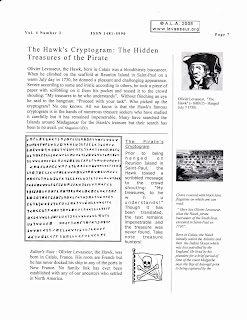I came across this article while web surfing. It offers a differing opinion as to whether John Julian, captured after surviving the wreck of the Whydah Galley was the Julian the Indian later executed in Boston, Massachusetts for killing a bounty hunter while attempting to escape slavery.
Posted Apr. 26, 2014 at 2:15 AM
Mystery of the Whydah survivors
Almost 300 years ago today, on the night of April 26, 1717, a
violent storm blasted the Cape and crashed a large sailing ship into the
sandbanks just off shore. Nearly all of the crew perished in the storm, the
bodies of many victims washing up near Marconi Beach. Today that shipwreck is
still making headlines, since the Whyd...
By Gregory N.
Flemming
Posted Apr. 26, 2014 at 2:15 AM
Almost 300 years ago today,
on the night of April 26, 1717, a violent storm blasted the Cape and crashed a
large sailing ship into the sandbanks just off shore. Nearly all of the crew
perished in the storm, the bodies of many victims washing up near Marconi
Beach. Today that shipwreck is still making headlines, since the Whydah is one
of the only pirate ships ever uncovered by divers. Three decades after the
initial discovery, Barry Clifford's Expedition Whydah continues to recover
gold, weapons and other artifacts from the ocean floor.
But one aspect of the
Whydah shipwreck remains a mystery. What happened to the two lone survivors who
swam ashore in the storm? One was an "Englishman" named Thomas Davis.
The other, according to newspaper reports and trial records, was an
"Indian" named John Julian. There is no record of what happened to
either of these survivors once they were taken to Boston shortly after the
wreck.
On the fateful morning of
Friday, April 26, the pirates in the Whydah had captured a vessel heading to
New York. The pirate captain, Samuel Bellamy, put seven men on the ship, but
those men "drank plentifully" of the wine they found aboard and soon
lost control of the vessel. The weather got worse with every passing hour.
Sometime after 10 that night, a horrendous storm pounded the coast, bringing
lightning and heavy sheets of rain. The Whydah sank just off Marconi Beach.
Nearly all of the more than 130 men aboard the Whydah died — except for Davis
and Julian.
The following Saturday,
Davis and Julian were taken to Boston on horseback with the seven other pirates
who had gotten drunk aboard the captured vessel. The men were tried for piracy
in Boston, and most were convicted and hanged. But the court believed Davis'
claims that he was innocent, a forced captive. John Julian, presumably because
he was an "Indian" and assumed to be a servant, was never brought to
trial.
Today, it is widely claimed
that Julian was sold into slavery and then executed 16 years later for murder.
The victim was a man named John Rogers, who was chasing a fugitive slave in
September 1732. The fugitive was called Julian the Indian, and Rogers captured
him later that day. When Julian tried running away again the next morning,
Rogers chased him into a cornfield. The two men struggled, and Rogers was
stabbed in the chest with a jackknife, dying almost immediately. Julian was
convicted of the murder and, ultimately, executed on Boston Neck in a snowstorm
on March 22, 1733.
Descriptions of the Whydah
survivors almost always suggest that John Julian was the same Julian who was
executed for John Rogers' murder 16 years later. But there is no conclusive
proof. In both instances Julian is described as an "Indian," but in
the trial following the Whydah shipwreck, he is specifically referred to as
John Julian. In every document surrounding the 1733 execution, the first name
John is never used — he is only described, in newspaper reports and execution
leaflets, as Julian, an Indian. The Expedition Whydah research also concludes
that Julian from the Whydah was a young man, maybe just 16 years old. In at
least one execution narrative attributed to Julian, he claims he lived with his
family until he was about 20.
Barry Clifford's divers
continue to uncover new evidence about the Whydah — more artifacts and
information than we have about any other pirate ship that sailed the Atlantic.
But the fate of the only two Whydah survivors, including John Julian, may
remain a mystery forever.
Gregory N. Flemming is the
author of "At the Point of a Cutlass: The Pirate Capture, Bold Escape, and
Lonely Exile of Philip Ashton," to be published in June (www.gregflemming.com).
You may view this on the original
web site if you wish at: http://www.capecodtimes.com/article/20140426/Opinion/404260341#ReaderReaction



